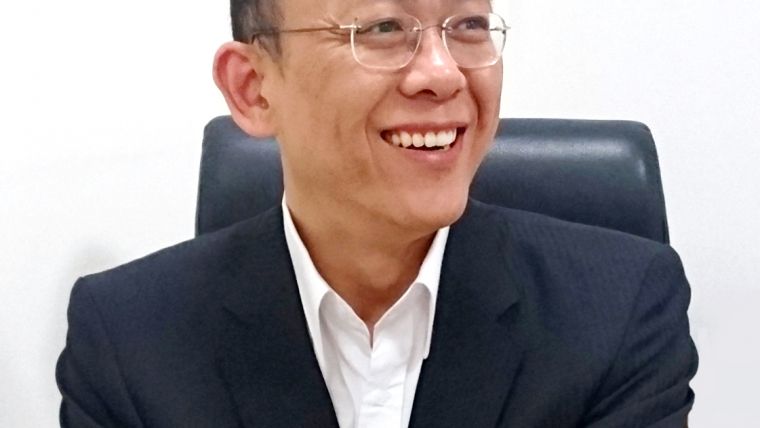5 Questions to...Super Wang, CEO of Supergeo
Super Wang is the founder and CEO of Supergeo, which has grown into a key player in the GIS industry. GIM International took the opportunity to ask him 5 questions about the company's history and its position within the industry today. Read on for his answers.
Which national and global developments triggered you to found Supergeo in 2001, 15 years ago? At that time, I had been working as a GIS specialist for several years and was quite well-known in Taiwan’s geospatial industry. Through my professional experience I was aware of the industry trend: exciting prospects for GIS development in emerging countries lay ahead, especially in the Asian countries. Most of them had large populations and territories, but they also faced difficulties in terms of further development, such as the lack of technologies for effective governance. There had to be an increasingly important role in these countries for GIS, as a key technology for modern management. Also, major GIS companies often lacked sufficient localisation, customisation and support in this region. After considering these factors, I decided it was a good time to fill the market niche by developing a new GIS software brand.
From serving the local market of Taiwan you evolved into an international player. Which challenges did you overcome, which ones still lie ahead of you and what distinguishes Supergeo from other global GIS players?
The hurdles we face are mostly about branding and marketing. Supergeo offers a complete geospatial solution, from field data collection to web map publishing. But when compared to other global players, it becomes apparent that we need more reliable partners in potential regions and we also want to indentify an effective marketing strategy to become more influential. In the past, the most significant advantages of Supergeo were our efficient support and our pricing. As mentioned above, major GIS firms could not provide appropriate products to meet the needs. But Supergeo does have that ability, since we wish to spread the power of GIS to more people with reasonable pricing and timely support. Recently, Supergeo has gradually altered course. To empower different industries making decisions based on spatial insights, we are now focusing more heavily on developing our state-of-the-art mobile GIS apps and solutions, which are easy to learn and easy to use for everyone.
The third dimension and the time component are becoming increasingly important, especially in dynamic urban conglomerates but also in hazard-prone areas. How are you responding to these challenging societal demands?
Supergeo is keen to capitalise on the emerging trend of GIS and respond to societal demands. In our latest product – SuperGIS Desktop 10 – we will enable users to create 3D visualisations with ease and it also has a novel tool that can dynamically display data with its temporal attributes. In terms of hazard prevention and response, we integrated various types of socioeconomic and environmental data to build a multifunctional online platform for the Atomic Energy Council of Taiwan using our web GIS technology and won the Asian Geospatial Excellence Award 2012. Furthermore, we developed Incident Command System, which can instantly display and query emergency situations for Taipei City Fire Department, and this project received the World Geospatial Excellence Award 2014. Furthermore, integrating urban hazard management and 3D environment, Supergeo has created an urban pipeline platform with SuperGIS 3D Earth Server. We are well prepared to meet these challenging demands with our latest GIS technologies.
How is your relationship with academia around the globe and how does that affect your R&D budget?
We always stay close to academia to access the latest ideas and technologies, because innovation remains a core value for Supergeo. In Taiwan, we continuously support and collaborate with the Laboratory for Geospatial Computational Science and Spatial Information Research Center from National Taiwan University. Internationally, Supergeo has also cooperated with Kuwait Institute for Scientific Research and we have empowered several universities to build their geospatial programmes with our special GIS package, including in Italy, Hong Kong, India, Malaysia and the Philippines. Based on a successful assessment, Supergeo is willing to support various research and educational projects with a considerable budget.
Which knowledge and skills would you expect from young professionals with a background in technology who want to build their career within your company?
For product designers and GIS analysts, the key ability would be the awareness of geography and the environment. I believe that in these positions people should know how to solve problems with GIS, so young professionals with related backgrounds such as geography, geosciences, forestry, surveying and urban planning are preferred. Other than that, it is also important to have sufficient knowledge about the IT industry. They must understand the trends like cloud technology, big data and the Internet of Things (IoT) to develop products based on the latest technologies. For programmers in the research and development department, it is important to have a passion for maps, which will help them to communicate with product designers more smoothly and build the products to meet demands more efficiently.

Value staying current with geomatics?
Stay on the map with our expertly curated newsletters.
We provide educational insights, industry updates, and inspiring stories to help you learn, grow, and reach your full potential in your field. Don't miss out - subscribe today and ensure you're always informed, educated, and inspired.
Choose your newsletter(s)
























